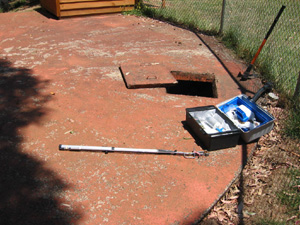One of the frequent problems seen in water tanks is smelly water. This can occur in above and below ground tanks and includes rain water tanks. People often describe the smell of their water as musty, decaying or like ammonia or rotten eggs. It can be just a little bit off-putting or in some cases can be very unpleasant. In any case its hard to drink and wash in smelly water.
The ammonia or rotten egg smell is a give away for anaerobic conditions. In other words poorly aerated water. The first test to do when investigating smelly tank water is a redox test. Redox or oxidation reduction potential is an indicator of oxygenation and unlike oxygen level tests redox can also show very anaerobic conditions.
Tests from one underground tank with smelly water showed that redox was 145 mV just below the water surface. Generally redox in the 200 – 250 mV range is commonly seen and acceptable for drinking water. Below 0 mV is definitely not good. So 145 mV was a little low but not too bad. However at the kitchen tap where water is drawn from deep in the tank the redox was -58 mV. Now that is bad! It indicates anaerobic water. This water had an unpleasant ‘eggy’ smell.

Checklist for smelly tanks:
- is there runoff entering the tank?
- have you been on holidays or have you just bought the property?
- do the downpipes from the roof go underground then come back up before the tank?
What can be done about smelly water? If the smell can be traced to anaerobic conditions the simplest thing to do is direct the stream from a garden hose back into the tank. Just ripple the water and try to get a slow circulating movement happening in the water. There’s no need to do anything too drastic like emptying the tank or throwing in handfulls of chlorine. All you need to do is get oxygen back into the water to reverse the reactions that created the smells in the first place. As a safeguard think about installing a cartridge water filter, one that has an activated carbon cartridge. That will help to remove some of the smells and will be good insurance against any future contamination. The Basic Water Quality Test from Apps Laboratories is designed to test water quality factors and can be used to trouble shoot water quality problems. Apps Labs also supplies rural and farm water filters.